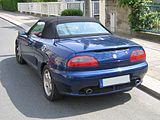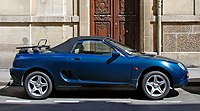MG F
| MG F / TF | |
|---|---|
| Production period: | 1995-2005; (2007-2011) |
| Class : | Sports car |
| Body versions : | Roadster |
| Previous model: | MG RV8 |
The MG F (since 2002: MG TF ) is a two-seat mid-engine - Roadster , which the MG Rover Group originally brought out in the fall 1995th It was the first new car specifically designed as an MG since the MGB was introduced in spring 1962, production of which was discontinued at the end of 1980.
The roadster was manufactured until mid-2005 when MG Rover had to file for bankruptcy.
From spring 2007 to the end of 2011, production took place under the new owner Nanjing Automobile Group from China .
history
MG had stopped manufacturing sports cars in late 1980 when BLMC closed its Abingdon plant . From 1982 to 1991 only sporty compact cars and sedans from Rover bore the MG badge.
In 1992, the MG Rover Group began manufacturing the MGB-based RV8 and the positive customer reaction led the company to launch the MG F. In 2002 the car was renamed “MG TF” in memory of the successful roadster model of the 1950s.
From early summer 2005, due to the settlement procedure via the MG Rover Group, further production was no longer possible. But in March 2007, when the Nanjing Automobile Group finished its MG factory in Nanjing , production started again. The brand was still MG . It lasted until the end of 2011.
Models
MG F (type RD, 1995–1999)
| 1st generation | |
|---|---|
|
MG F 1.8 (1995-1999) |
|
| Production period: | 1995-1999 |
| Body versions : | Roadster |
| Engines: |
Petrol engines : 1.8 liters (88-107 kW) |
| Length: | 3914 mm |
| Width: | 1630 mm |
| Height: | 1260 mm |
| Wheelbase : | 2375 mm |
| Empty weight : | 1070-1087 kg |
The MG F was introduced by the MG Rover Group in autumn 1995. The market launch in Germany took place in January 1996.
The MG F was the third new model to come out in the 12 months after it was acquired by BMW . The MG F was already fully developed for production; However, BMW initially banned production to check whether the MG F would compete with the BMW Z3 in-house. The car has a 1.8-liter in-line four-cylinder Rover K-series engine with 16 valves, double camshafts and hydraulic valve lifters . The motor itself is made entirely of aluminum and is structured like a sandwich (head-to-block warehouse ladder, oil distributor). This design creates a low center of gravity and is very rigid due to its compactness. In the basic version the engine has an output of 88 kW (120 PS) and in the VVC version with variable valve control 107 kW (146 PS). Rover Special Projects monitored the development of the construction and commissioned external service providers to select the best proposals for the mechanical design before it was completed. MGA Developments provided the original design principle (which many believed was that of an enlarged Honda Beat ), which MG Rover engineers under Gerry McGovern developed further.
An interesting detail on the F is the Hydragas chassis, a system in which interconnected liquid shock absorbers and gas springs (nitrogen filling) ensure astonishing ride comfort. Furthermore, the wheel suspension consists of complex double wishbones, as is usually the case with much more expensive sports cars.
The MG F immediately topped the UK's most popular sports car list when it was launched. It stayed there until the successor TF was introduced in spring 2002.
Engines
- 1.8-liter 4-cylinder gasoline engine with 1796 cm³ displacement and 88 kW (120 PS); 04 / 1995-09 / 1999
- 1.8-liter 4-cylinder petrol engine with 1796 cm³ displacement and 107 kW (146 hp); 04 / 1995-09 / 1999
MG F (type RD, 1999–2002)
| 1st generation (facelift) | |
|---|---|
|
MG F (1999-2002) |
|
| Production period: | 1999-2002 |
| Body versions : | Roadster |
| Engines: |
Petrol engines : 1.6–1.8 liters (82–118 kW) |
| Length: | 3910 mm |
| Width: | 1630 mm |
| Height: | 1270 mm |
| Wheelbase : | 2380 mm |
| Empty weight : | 1075-1165 kg |
In autumn 1999 the MG F was given a facelift . The vehicle received a modified interior (speedometer sheets, digital odometer, seats, door panels and center console), styling changes such as the color of the turn signal housing, windshield frame in the vehicle color and modified aluminum rims.
There was now a four-cylinder base engine with 1.6 l displacement and 82 kW (112 hp) as well as a powerful Trophy 160 version with 1.8 l displacement and 118 kW (160 hp). This accelerated from 0-100 km / h in 6.9 s and reached a top speed of 220 km / h. The Trophy was only built 1430 times.
In the spring of 2000, a model with a continuously variable transmission, the so-called CVT transmission ( Steptronic ) was introduced, which had a 1.8-liter engine with an output of 88 kW (120 PS).
The F continued to sell well despite BMW's sale of MG Rover Group, announced in March 2000. Land Rover went to Ford , while the MG and Rover brands were sold to the Phoenix Consortium for £ 10. Despite competition from the Mazda MX-5 , BMW Z3 and Audi TT , the MG F remained quite popular.
Engines
- 1.6-liter 4-cylinder gasoline engine with 1588 cm³ displacement and 82 kW (112 hp); 09 / 2000-02 / 2002
- 1.8-liter 4-cylinder gasoline engine with 1796 cm³ displacement and 88 kW (120 PS); 08/1999–05/2002
- 1.8-liter 4-cylinder petrol engine with 1796 cm³ displacement and 107 kW (146 hp); 08/1999–05/2002
- 1.8-liter 4-cylinder gasoline engine with 1796 cm³ displacement and 118 kW (160 PS); 10 / 2001–05 / 2002
MG TF (2002-2005)
| 2nd generation | |
|---|---|
|
MG TF 160 (2002-2005) |
|
| Production period: | 2002–2005 2007–2011 |
| Body versions : | Roadster |
| Engines: |
Petrol engines : 1.6–1.8 liters (85–118 kW) |
| Length: | 3943 mm |
| Width: | 1628 mm |
| Height: | 1261 mm |
| Wheelbase : | 2375 mm |
| Empty weight : | 1095-1125 kg |
| Stars in the Euro NCAP - Crash Test |
|
In a further facelift in spring 2002, the F became the MG TF , named after the classic MG TF of the 1950s.
The most important changes were the replacement of the Hydragas system with conventional coil springs, due to the fact that the Rover 100 , which uses the same system, was withdrawn from the market due to very poor results in the crash test and the production of the system is suitable for the MG TF would not have calculated alone. There was also a redesign of the intake system for the engine, which, together with the new camshafts, provided increased power, and the torsional stiffness of the body was increased by 20%. There were also some styling changes such as a new radiator grille, changed headlights, bumpers and intake openings, bonnet, etc. The 1.6-liter four-cylinder engine in the MG TF also developed 85 kW (115 PS). In addition to the 1.8-l variants with 88 kW (120 PS) or 118 kW (160 PS), a third version with 100 kW (136 PS) was also offered.
The MG TF was the first car in its class to receive four stars in the Euro NCAP crash test. It also received the coveted " Convertible of the Year 2002" award from the COTY jury.
The MG F / TF was the most successful and best-known MG model in England for almost eleven years of production. Probably because of the WEEE and RoHS legislation, the MG TF was systematically changed in the years 2002 to 2004 for conformity in the individual details, externally recognizable by the replacement of the PVC rear window with a heated glass rear window for a small number of 631 MG TF im Year 2005.
Like the MG F before it, the MG TF sold better than its competitors throughout its production time in the UK. Manufacturing stopped in mid-2005 when the MG Rover Group collapsed.
Technical specifications
| model | Displacement (cm³) |
power | Torque | Top speed (km / h) |
Acceleration (0-100 km / h) |
construction time |
|---|---|---|---|---|---|---|
| MG TF 115 | 1588 | 85 kW (116 hp) at 6250 rpm | 145 Nm at 4700 rpm | 190 | 9.8 s | 04 / 2002-09 / 2005 |
| MG TF 120 step speed | 1796 | 88 kW (120 PS) at 5500 rpm | 165 Nm at 3000 rpm | 190 | 10.2 s | 04 / 2002-09 / 2005 |
| MG TF 135 | 1796 | 100 kW (136 hp) at 6750 rpm | 165 Nm at 5000 rpm | 205 | 8.8 s | 04 / 2002-09 / 2005 |
| MG TF 160 | 1796 | 118 kW (160 PS) at 6900 rpm | 174 Nm at 4700 rpm | 220 | 7.6 s | 04 / 2002-09 / 2005 |
Manufactured by the Nanjing Automobile Group
While the production facilities of various rovers were dismantled and shipped to China, the line for the MG TF remained in Longbridge. On February 21, 2006, the Nanjing Automobile Group , which bought what was left of MG Rover during the settlement process, signed a lease for the southern Longbridge facility. The paint shop, two vehicle production lines and offices were located there.
From May 2007 to the end of 2011 the new MG TF was finally assembled there. Around 150 new jobs were created. The revised shape of the car made use of design elements from the MGF from 1995. After the start of sales in Great Britain was postponed several times due to quality problems with supplier parts procured from China, sales of 500 right-hand drive MG TFs started in August 2008 with the special model TF LE 500 in six colors. Production was to be continued in small series for the English market in 2009, but sales of the LE-500 models are stagnating. In early 2009 they are even trying to sell these right-hand drive vehicles on the mainland. In total, only 906 vehicles were produced.
In addition, the TF was built in a new plant in Nanjing , China, which was designed for up to 200,000 vehicles per year.
Web links
- MG F / TF Central, a website for links, tips, tricks and instructions
- EXTREME MGF website and concepts
- Press release about the EX255
- The MG F at 348 km / h, The Daily Telegraph, Saturday, August 30, 1997 (English)
Individual evidence
- ↑ The MG TF in the Euro NCAP crash test
- ^ Austin MG Metro history . In: AROnline . July 23, 2011 ( aronline.co.uk [accessed March 8, 2017]).
- ↑ http://www.aronline.co.uk/blogs/2011/04/13/mg6-production-underway-in-longbridge/
- ↑ BBC Webnews: Chinese plans rolls out first MG











